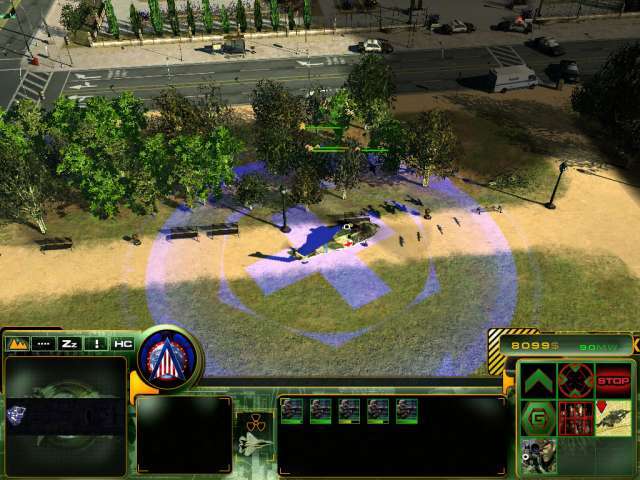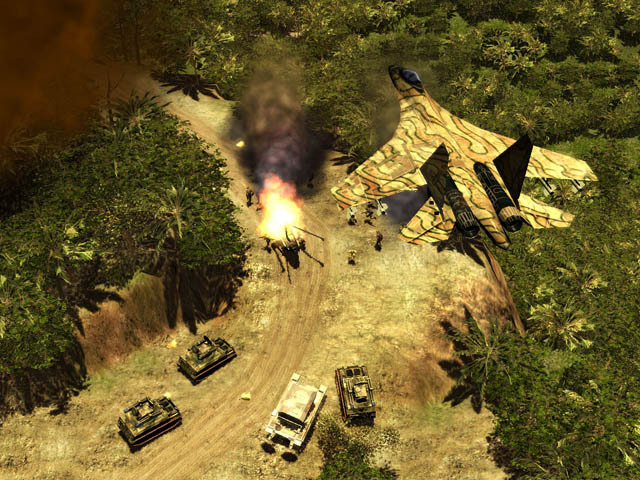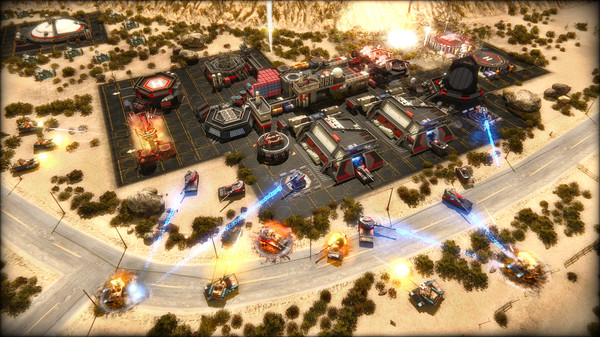Developed by Eugene Systems and published by Atari back in 2005, Act of War: Direct Action is basically what you get if Tom Clancy decided to make a Command & Conquer-like RTS game. Despite fairly solid reviews, Act of War was largely ignored back when it originally came out, which is a damn shame because it was a great RTS that introduced a lot of really unique mechanics. I’ve been meaning to talk about this one for a while now, and now just seems like the perfect time to tell you why you should pick up this criminally overlooked RTS classic.
When I say that Act of War is C&C by way of Tom Clancy, I’m not joking. The game’s story was written in collaboration with Dale Brown, a famous New York Times bestselling author known for his techno-military thrillers. In fact, he even wrote two Act of War novels. The game features incredibly cheesy live-action cut-scenes, just like in C&C. Set in “the near future,” gas prices have skyrocketed to the outlandish $7 a gallon. Just roll with it, $7 a gallon seemed a lot more ridiculous back then. Major Richter from the top-secret US special operations unit Task Force Talon is placed in charge of the war against the Consortium, a surprisingly well-equipped and organized terrorist organization being manipulated by a Russian oil baron attempting to establish a worldwide energy monopoly.
 The game features three factions that play fairly different from each other. The US Military focuses on tried and true conventional weapons and vehicles. The US Military units are highly specialized and tend to be the best and most durable in their class at the cost of flexibility. Their tech tree also takes a bit longer to advance through, and comes in several DEFCON stages that must be purchased in order to unlock their most advanced units.
The game features three factions that play fairly different from each other. The US Military focuses on tried and true conventional weapons and vehicles. The US Military units are highly specialized and tend to be the best and most durable in their class at the cost of flexibility. Their tech tree also takes a bit longer to advance through, and comes in several DEFCON stages that must be purchased in order to unlock their most advanced units.
Task Force Talon focuses on multirole drone units that often have several modes to choose from. Their Stryker APC, for example, starts as just a generic transport that can swap out its transportation capabilities for a 105mm gun to take down armored targets or a mortar for long-range fire support. This gives their units significantly more flexibility than the other factions, but they don’t excel at any particular role like the more conventional US Military. Their units also tend to be much more micro-intensive because they rely more on these swappable weapon modes to adapt to the current situation.
Finally, the Consortium is an interesting mix that starts out with very cheap, disposable units. Their early units are pretty weak compared to the US Military or Talon, but they can quickly amass large numbers of them due to their very low costs and short production times. The latter half of their tech tree is the polar opposite of their early game. During the mid-to-late stages, the Consortium gains access to a wide range of expensive, high-tech units, many of which employ experimental stealth technologies. Still, their units remain fairly fragile, requiring increased focus on ambushes and hit-and-run tactics in the late game.
One of the more unique mechanics in Act of War was the POW system, something I haven’t really seen done since. Sometimes, infantry would enter a heavily wounded state instead of being outright killed. Even destroyed vehicles had a chance of spawning a driver or pilot before exploding. Wounded infantry could be rescued by medivac vehicles, while drivers or pilots could be sent back to your base and, if they made it, you got a small portion of their unit cost back. However, if you can’t rescue these units in time, enemy infantry could capture them as POWs. POWs generate a small amount of income while held in a camp or prison building, and you could trade in POW’s for map information.

There were also special buildings on the map, like banks, that you could garrison with infantry to gain a steady stream of cash. Garrisoning or hiding infantry in cover kept infantry viable throughout the game, especially in the game’s many urban maps. Act of War was one of those few RTS games where units didn’t really become obsolete as the game dragged on, and it openly encouraged you to rely on a wide range of different units instead of spamming a handful of general-purpose ones.
The game had a fairly interesting take on aircraft too, for the time. Helicopters were controlled in a fairly conventional way, but fighters and bombers were treated as a type of support ability that flies in from off the map. You attached fighters to air control towers and placed down a marker where you wanted the aircraft to fly to. As the fighter flew to the target area it would fire upon any valid targets, but hold back at least half of its munitions for when it got to the target. This meant that you didn’t directly control fighters and had to really time your airstrikes, not only taking into consideration what you wanted to bomb but also anything that could pose a threat to your aircraft on the way to the target location.

While Act of War didn’t receive the recognition it deserved when it came out, Eugene Systems is finally returning with Act of Aggression, a spiritual successor that releases in a few days. Act of Aggression features many of the mechanics from Act of War, like POWs and the way the game handles aircraft and superweapons. Act of Aggression will also introduce a new resource called Rare Earth Metals, and this new resource is handled in an interesting way that I’ve never seen before in an RTS. These rare resources are randomly generated, so you can play a map over and over again and never know exactly where these resources will be hidden. This adds an interesting twist to scouting and map exploration, and gives the maps a bit more replayability.
The factions themselves are ripped straight from Act of War, but updated with new vehicles and weapon systems that have been developed in the decade since that game came out. The US Military returns and looks to play roughly the same as they did before, with an arsenal of battle-tested conventional units that, when fully upgraded, are generally the best in their class. The Chimera is a UN-funded peacekeeping group that focuses on advanced and often experimental technology, and plays similar to Task Force Talon with an emphasis on very adaptable multirole units. Finally, the Cartel is a powerful PMC and Act of Aggression‘s version of the Consortium. Unlike the Consortium they focus on more elite units over disposable hordes, but still retain all the tricksy stealth technology that often requires vast stockpiles of all three resources to produce and maintain.

If you want to check out this forgotten RTS classic, I highly recommend getting Act of War: Gold Edition on GOG. Even if you read this after the 70% discount is over, it’s only $10 for Direct Action and the High Treason expansion pack on GOG, as opposed to buying both individually for $10 each on Steam. While you are at it, keep an eye out for Act of Aggression. I’ve been hearing a lot of good things about it from people in the current beta. It comes out on September 2nd, and preordering gets you a copy for 15% off and instant access to the multiplayer and skirmish beta.
Frank is an aspiring game designer that currently writes for Gameverse, IndieGameSource, and Bell of Lost Souls. You can follow him on Twitter @Frank_Gaming for updates on future articles and reviews.
